Traditionalist Issues
 |
 |
 |
 |
 |
 |
 |
Dialogue Mass - XV
A Self-Contradictory Liturgical Reform
With Mediator Dei of 1947, Pius XII had set the stage for “active participation” of the laity. Not only did he strongly encourage the “Dialogue Mass” and congregational singing in this encyclical, but he also exhorted the Bishops to set up diocesan committees to ensure that these revolutionary measures “in which the people take part in the liturgy” would be everywhere promoted as a “liturgical apostolate” for the laity. (1)
Here we see the first intimation of the “theology of lay liturgical ministry” that would be ordered by Vatican II, whereby the whole assembly shares the responsibility for celebrating Mass. Thus, Pius XII effectively undermined his own teaching on the Catholic priesthood found elsewhere in the same document. With such confusion between the ordained and the non-ordained, is there any wonder that there developed a crisis of priestly identity?
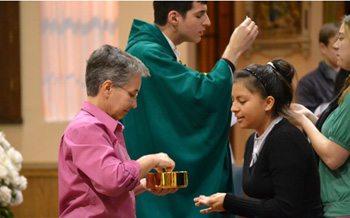 Almost immediately following the encyclical, Pius XII placed Fr. Annibale Bugnini in charge of a Commission for the General Reform of the Liturgy staffed by a few hand-picked “progressivist” satraps. (2)
Almost immediately following the encyclical, Pius XII placed Fr. Annibale Bugnini in charge of a Commission for the General Reform of the Liturgy staffed by a few hand-picked “progressivist” satraps. (2)
The first result of the Commission’s work was the restructuring of the Easter Vigil rite (1951) with a view to promoting “active participation” leading to an entire revision of the Holy Week liturgy in 1955. This in turn would spawn all subsequent liturgical reforms up to and after Vatican II, with the same rationale in mind.
There was no doubt in the minds of the two most influential members of the Commission, Fr. Bugnini and Fr. Ferdinando Antonelli, that the reforms they devised in the 1950s were based on the same principles as the post-conciliar reforms.
Bugnini made several statements to the effect that the 1955 reforms were a transitional stage of a more general liturgical reform, “the first step toward measures of a wider scope,” “an arrow” pointing forward. (3) Fr. Antonelli, future Secretary of the Liturgical Commission of Vatican II and Secretary of the Congregation of Rites, stated that his revision of the Roman rite under Pius XII was simply a “kind of novitiate” for the official reforms of Vatican II and later. (4)
When Bugnini’s chickens came home to roost
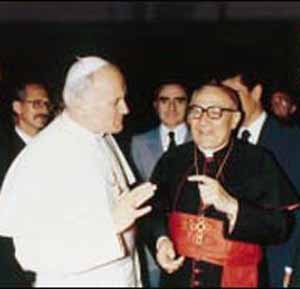 How ironic that Fr. Antonelli (later Cardinal), who had been given chief responsibility on Pius XII’s Commission for the reform of Holy Week, later deplored the outcome of what he had initiated in the 1950s. In his memoirs, he noted:
How ironic that Fr. Antonelli (later Cardinal), who had been given chief responsibility on Pius XII’s Commission for the reform of Holy Week, later deplored the outcome of what he had initiated in the 1950s. In his memoirs, he noted:
“Many of those who have influenced the reform ... and others, have no love and no veneration for that which has been handed down to us. They begin by despising everything that is actually there. This negative mentality is unjust and pernicious … with this mentality they have only been able to demolish and not to restore.” (5)
Precisely. Yet at that critical point in history when papal support for the protection of the traditional rites was essential, Pius XII was on the wrong side, aligning himself with those who aimed to demolish Tradition.
The hermeneutic of rupture
Continuity with Tradition was exactly what Pius XII’s Commission did not want, as was made abundantly clear in the 1951 Decree (6) introducing an experimental Easter Vigil service and also in the 1955 Decree (7) making it (and the whole of the Holy Week reforms) obligatory for the Roman rite. Both of these Decrees, as we shall see below, contain unjustified criticisms of the traditional rites; they are also accompanied by Instructions for new rites in which the emphasis was placed on the “active participation” of the laity.
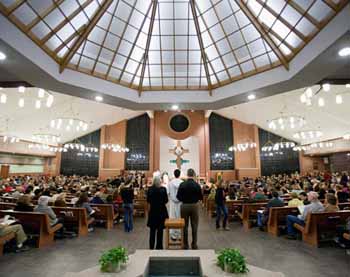 Here we see the first glimmerings of a new approach to liturgy – known later as “horizontalism.” The ordering and meaning of Catholic worship was now in the hands of the reformers who began systematically to replace rituals that transmitted a sense of reverence and awe in the presence of God with “simplified” man-centred constructs promoting “active participation.”
Here we see the first glimmerings of a new approach to liturgy – known later as “horizontalism.” The ordering and meaning of Catholic worship was now in the hands of the reformers who began systematically to replace rituals that transmitted a sense of reverence and awe in the presence of God with “simplified” man-centred constructs promoting “active participation.”
By 1955, with the Decree Maxima Redemptionis, the shape of this most ancient of Vigils (which St. Augustine called the “Mother of all Vigils”) was reformulated and some texts were massively curtailed. And new arrangements were invented for the priest to face the people, involving “dialogue” with them in the vernacular. One could say that the decline of the sense of the sacred began in embryonic form with the 1951-1955 changes.
False dawn of the Easter Vigil reform
Under pressure from the French and German Bishops, Pius XII made a new rule that the Church should no longer hold the Easter Vigil in daylight hours, as had been the case since the 7th or 8th centuries, but should revert to the practice of the first Christians who held it after dark.
No convincing reason was given by the Congregation of Rites as to why the night time should be deemed the “proper hour” for the Vigil service. In fact, there is no “proper” hour for a vigil.The mystery of the Church's liturgy is, in its essence, not bound by the clock. In liturgical terms, a vigil refers to the eve of a feast day and can be celebrated with propriety at any time of the day.
However, Maxima Redemptionis arbitrarily insisted that the ceremonies “may not begin before twilight, or certainly not before sunset.” But the timing of the Easter Vigil had never been set by astronomical calculation, as if everything depended on how many degrees the sun is above or below the horizon.
The self-contradictory nature of the Easter Vigil reform
The Church was ordered to return to the catacombs. It is perplexing that the same Pope who had condemned such a retrograde step in the strongest terms as “antiquarianism” only four years earlier, could have countenanced this reversal of his own teaching:
“The liturgy of the early ages is most certainly worthy of all veneration. But ancient usage must not be esteemed more suitable and proper, either in its own right or in its significance for later times and new situations, on the simple ground that it carries the savor and aroma of antiquity. The more recent liturgical rites likewise deserve reverence and respect. They, too, owe their inspiration to the Holy Spirit, who assists the Church in every age even to the consummation of the world. They are equally the resources used by the majestic Spouse of Jesus Christ to promote and procure the sanctity of man.” (8)
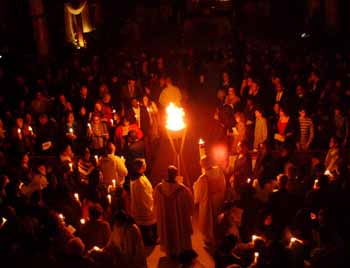 But the point about his 1955 Decree Maxima Redemptionis was that it did state that the early Christian Easter Vigil was “more suitable and proper” than what had developed over the intervening centuries; and it did reject the principle that “the more recent liturgical rites likewise deserve reverence and respect.”
There is no mistaking the language used in the Decree to denigrate the liturgical tradition as it had developed up to the 1950s. Maxima Redemptionis carried a note of reprobation of what had been approved and maintained as Catholic practice for centuries, with the scarcely veiled implication that for most of her history the Church had conducted her worship on wrong lines.
But the point about his 1955 Decree Maxima Redemptionis was that it did state that the early Christian Easter Vigil was “more suitable and proper” than what had developed over the intervening centuries; and it did reject the principle that “the more recent liturgical rites likewise deserve reverence and respect.”
There is no mistaking the language used in the Decree to denigrate the liturgical tradition as it had developed up to the 1950s. Maxima Redemptionis carried a note of reprobation of what had been approved and maintained as Catholic practice for centuries, with the scarcely veiled implication that for most of her history the Church had conducted her worship on wrong lines.
In it, the accusation was made that the Easter Vigil had lost its original clarity and the meaning of its words and symbols when it was “torn” from its “proper” nocturnal setting and was no longer in line with the Gospel accounts. According to the reformers, it had even become “harmful” to the symbolic meaning of the Vigil. (9) Anyone would think they were referring to a monstrous iniquity that must be removed from the Church.
In other words, the Holy See (echoing the reformers) was claiming that the public prayers of the Church celebrated continually for many centuries, sanctified by long usage and codified by the Council of Trent were theologically defective and liturgically “improper.”
Is it conceivable that the traditional manner of celebrating the Easter Vigil in the daytime was a disastrous mistake and that the Church had to wait 14 centuries for Bugnini and his henchmen to put the matter right?
Of course not, and in the next instalment we will be examining the spurious reasons for the Easter Vigil changes, which were published in the 1951 and 1955 Decrees.
Continued

Here we see the first intimation of the “theology of lay liturgical ministry” that would be ordered by Vatican II, whereby the whole assembly shares the responsibility for celebrating Mass. Thus, Pius XII effectively undermined his own teaching on the Catholic priesthood found elsewhere in the same document. With such confusion between the ordained and the non-ordained, is there any wonder that there developed a crisis of priestly identity?

Today's lay eucharistic ministers act as participants of the priesthood - Diocese of Austin, Texas
The first result of the Commission’s work was the restructuring of the Easter Vigil rite (1951) with a view to promoting “active participation” leading to an entire revision of the Holy Week liturgy in 1955. This in turn would spawn all subsequent liturgical reforms up to and after Vatican II, with the same rationale in mind.
There was no doubt in the minds of the two most influential members of the Commission, Fr. Bugnini and Fr. Ferdinando Antonelli, that the reforms they devised in the 1950s were based on the same principles as the post-conciliar reforms.
Bugnini made several statements to the effect that the 1955 reforms were a transitional stage of a more general liturgical reform, “the first step toward measures of a wider scope,” “an arrow” pointing forward. (3) Fr. Antonelli, future Secretary of the Liturgical Commission of Vatican II and Secretary of the Congregation of Rites, stated that his revision of the Roman rite under Pius XII was simply a “kind of novitiate” for the official reforms of Vatican II and later. (4)
When Bugnini’s chickens came home to roost

A first reformer, Fr. Antonelli was granted a cardinal's hat and prestige from the Popes
“Many of those who have influenced the reform ... and others, have no love and no veneration for that which has been handed down to us. They begin by despising everything that is actually there. This negative mentality is unjust and pernicious … with this mentality they have only been able to demolish and not to restore.” (5)
Precisely. Yet at that critical point in history when papal support for the protection of the traditional rites was essential, Pius XII was on the wrong side, aligning himself with those who aimed to demolish Tradition.
The hermeneutic of rupture
Continuity with Tradition was exactly what Pius XII’s Commission did not want, as was made abundantly clear in the 1951 Decree (6) introducing an experimental Easter Vigil service and also in the 1955 Decree (7) making it (and the whole of the Holy Week reforms) obligatory for the Roman rite. Both of these Decrees, as we shall see below, contain unjustified criticisms of the traditional rites; they are also accompanied by Instructions for new rites in which the emphasis was placed on the “active participation” of the laity.

The ‘horizontal’ church reflected in an egalitarian architecture & liturgy
By 1955, with the Decree Maxima Redemptionis, the shape of this most ancient of Vigils (which St. Augustine called the “Mother of all Vigils”) was reformulated and some texts were massively curtailed. And new arrangements were invented for the priest to face the people, involving “dialogue” with them in the vernacular. One could say that the decline of the sense of the sacred began in embryonic form with the 1951-1955 changes.
False dawn of the Easter Vigil reform
Under pressure from the French and German Bishops, Pius XII made a new rule that the Church should no longer hold the Easter Vigil in daylight hours, as had been the case since the 7th or 8th centuries, but should revert to the practice of the first Christians who held it after dark.
No convincing reason was given by the Congregation of Rites as to why the night time should be deemed the “proper hour” for the Vigil service. In fact, there is no “proper” hour for a vigil.The mystery of the Church's liturgy is, in its essence, not bound by the clock. In liturgical terms, a vigil refers to the eve of a feast day and can be celebrated with propriety at any time of the day.
However, Maxima Redemptionis arbitrarily insisted that the ceremonies “may not begin before twilight, or certainly not before sunset.” But the timing of the Easter Vigil had never been set by astronomical calculation, as if everything depended on how many degrees the sun is above or below the horizon.
The self-contradictory nature of the Easter Vigil reform
The Church was ordered to return to the catacombs. It is perplexing that the same Pope who had condemned such a retrograde step in the strongest terms as “antiquarianism” only four years earlier, could have countenanced this reversal of his own teaching:
“The liturgy of the early ages is most certainly worthy of all veneration. But ancient usage must not be esteemed more suitable and proper, either in its own right or in its significance for later times and new situations, on the simple ground that it carries the savor and aroma of antiquity. The more recent liturgical rites likewise deserve reverence and respect. They, too, owe their inspiration to the Holy Spirit, who assists the Church in every age even to the consummation of the world. They are equally the resources used by the majestic Spouse of Jesus Christ to promote and procure the sanctity of man.” (8)

A post-Vatican II Easter Vigil celebration in the Los Angeles Cathedral
In it, the accusation was made that the Easter Vigil had lost its original clarity and the meaning of its words and symbols when it was “torn” from its “proper” nocturnal setting and was no longer in line with the Gospel accounts. According to the reformers, it had even become “harmful” to the symbolic meaning of the Vigil. (9) Anyone would think they were referring to a monstrous iniquity that must be removed from the Church.
In other words, the Holy See (echoing the reformers) was claiming that the public prayers of the Church celebrated continually for many centuries, sanctified by long usage and codified by the Council of Trent were theologically defective and liturgically “improper.”
Is it conceivable that the traditional manner of celebrating the Easter Vigil in the daytime was a disastrous mistake and that the Church had to wait 14 centuries for Bugnini and his henchmen to put the matter right?
Of course not, and in the next instalment we will be examining the spurious reasons for the Easter Vigil changes, which were published in the 1951 and 1955 Decrees.
Continued
- “Wherefore We exhort you, Venerable Brethren, that each in his diocese or ecclesiastical jurisdiction supervise and regulate the manner and method in which the people take part in the liturgy, according to the rubrics of the Missal and in keeping with the injunctions which the Sacred Congregation of Rites and the Code of Canon Law have published. … It is also Our wish that in each diocese an advisory committee to promote the liturgical apostolate should be established.” (Mediator Dei, n. 109)
- The members of the Commission in 1948 were: Card. Clemente Micara, Pro-Prefect of the Sacred Congregation of Rites (President); Fr. Annibale Bugnini CM (Secretary); Msgr. Alfonso Carinci, Secretary of the Congregation of Rites; Fr. Agostino Bea SJ; Fr. Ferdinando Antonelli OFM; Fr. Joseph Löw CSSR; Dom Anselmo Albareda OSB, Prefect of the Vatican Library.
- A. Bugnini, The Simplification of the Rubrics: Spirit and Practical Consequences of the Decree of the Sacred Congregation of Rites March 23, 1955, with a Preface by Ferdinando Antonelli, Collegeville, MN: Doyle & Finegan, , 1955.
- Cf. Nicola Giampietro, The Development of the Liturgical Reform: As Seen by Cardinal Ferdinando Antonelli from 1948-1970, Fort Collins CO: Roman Catholic Books, 2009, p. 69. Giampietro gleaned his information from research into Antonelli’s personal writings as well as archival material from the minutes of the Commissions on which the Cardinal had served.
- Ibid., p. 192. This is not to suggest that Card. Antonelli wanted to preserve intact the Church’s liturgical tradition. He was Secretary for the Liturgical Commission of the Second Vatican Council, a member of the post-conciliar Concilium and became Secretary of the Sacred Congregation for Rites in 1965.
- De solemni vigilia paschali instauranda, Acta Apostolicae Sedis, 1951, pp. 128-37. There exists no English translation.
- Maxima Redemptionis, Acta Apostolicae Sedis, 1955, pp. 838-847.
- Mediator Dei, 1947 n. 61.
- Maxima Redemptionis: “profecto non sine detrimento liturgici sensus, nec sine confusione inter evangélicas narrationes et ad eas pertinentes liturgicas repraesentationes. Solemnis praesertim paschalis vigiliae liturgia, a propria nocturna sede avulsa, nativam perspicuitatem ac verborum et symbolorum sensum amisit.” (certainly not without detriment to the liturgical meaning, creating confusion among the Gospels accounts and related liturgical ceremonies. Principally the solemn liturgy of the Easter Vigil, snatched away from its proper nightly time, lost its innate clarity as well as the meaning of words and symbols) The expression avulsa (“snatched away”) is offensive and unwarranted, as it has a particularly violent connotation in Latin, descriptive of robbery, abduction etc.

Posted January 19, 2015
______________________
______________________
 Volume I |
 Volume II |
 Volume III |
 Volume IV |
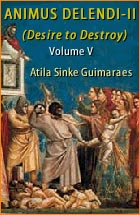 Volume V |
 Volume VI |
 Volume VII |
 Volume VIII |
 Volume IX |
 Volume X |
 Volume XI |
 Special Edition |


